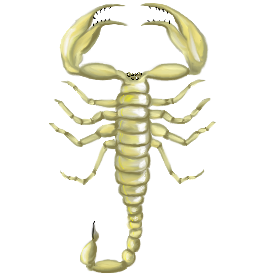Desert dune scorpion
From Wikimalia
| (One intermediate revision not shown.) | |||
| Line 2: | Line 2: | ||
|image=Desert Dune Scorpion.png | |image=Desert Dune Scorpion.png | ||
|name=Desert Dune Scorpion | |name=Desert Dune Scorpion | ||
| - | |habitat= | + | |habitat=Tropical and equatorial deserts. |
| - | |description= | + | |description=Perhaps no longer than a quarter- to a half-thum, this diminutive arachnid often appears somewhat translucent in direct sunlight. Such coloration allows the scorpion to blend well with its natural sandy backdrop. |
| + | A pair of oversized pincers protrude from the anterior of the scorpion's carapace, capable of seizing much larger prey than itself. Its prehensile coiled tail typically lies flat to one side or the other, allowing the scorpion to quickly become nearly invisible in flat sands. | ||
|collection= | |collection= | ||
| - | |notes= | + | |notes=Utterly nocturnal, the desert dune scorpion is only seen in daylight when it is surprised in its lair, usually to the detriment of the discoverer. Gaining all its liquid intake from its prey, it hunts constantly and aggressively, seeming to prefer larger species of scorpions as its mainstay. It has also been known to lie dormant in or near the entrances to rodent burrows, cactus-borne bird nests, as well as lurking in the coolest shade during the day. |
}} | }} | ||
| + | There is a desert adage regarding the size and coloration of scorpions that holds doubly true with the Desert dune scorpion. The smaller the adult scorpion, typically, the more aggressive they are, and the lighter the coloration, the more deadly the venom. Barely a creamy yellowish tan and invariably less than an inch long, it is both aggressive and highly toxic. | ||
| + | Countless desert folk and animals have fallen to this very successful predator, and many more are likely to in the future. | ||
| + | Such deadliness, however, has not deterred a black market from cropping up in many outlying desert communities of capturing and training these arachnids to fight one another. Gambling on the outcomes of scorpion duels is considered barbaric in many cultures, including those that participate in it the most enthusiastically. | ||
| + | |||
{{stub}} | {{stub}} | ||
Back to the [[Insect/Arachnid]] page. | Back to the [[Insect/Arachnid]] page. | ||
Current revision
| The Bug Collection | ||||||||
|---|---|---|---|---|---|---|---|---|
|
| ||||||||
| ||||||||
There is a desert adage regarding the size and coloration of scorpions that holds doubly true with the Desert dune scorpion. The smaller the adult scorpion, typically, the more aggressive they are, and the lighter the coloration, the more deadly the venom. Barely a creamy yellowish tan and invariably less than an inch long, it is both aggressive and highly toxic. Countless desert folk and animals have fallen to this very successful predator, and many more are likely to in the future. Such deadliness, however, has not deterred a black market from cropping up in many outlying desert communities of capturing and training these arachnids to fight one another. Gambling on the outcomes of scorpion duels is considered barbaric in many cultures, including those that participate in it the most enthusiastically.
This article is a stub. You can help Wikimalia by expanding it.
Back to the Insect/Arachnid page.

